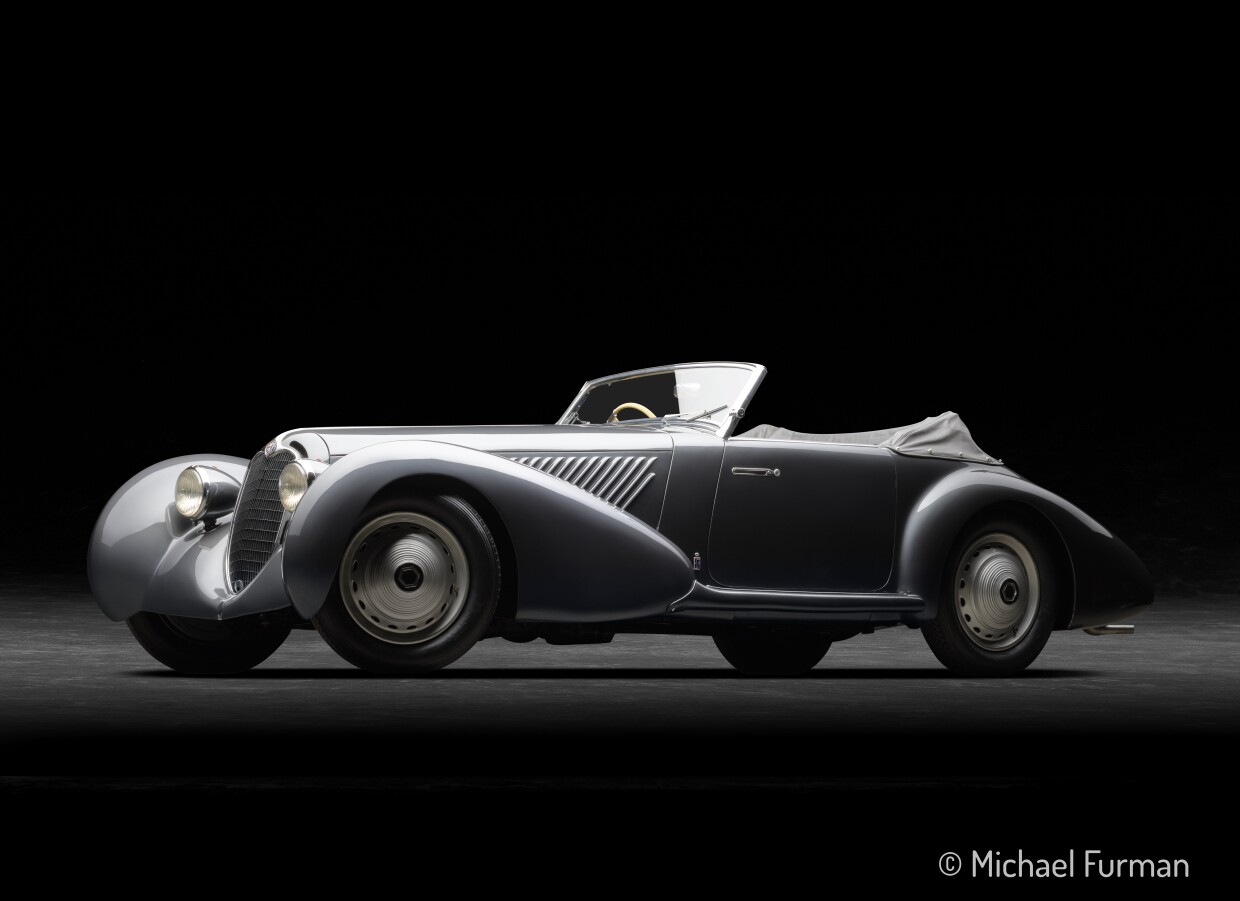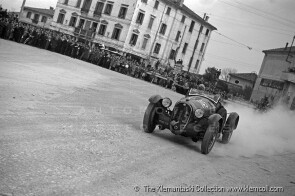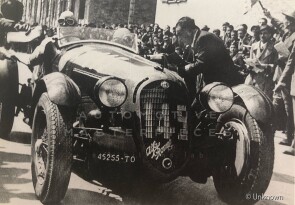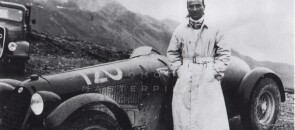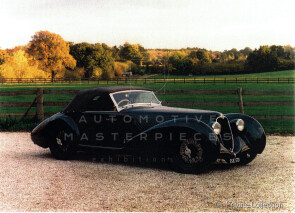
1937 Alfa Romeo 8C 2900 B
ON/OFF
Why am I an Automotive Masterpiece?
G. Team cars
Suadra Automobilistica Torino SA (IT)
L. Limited edition cars
no. 2 manufactured
The Alfa Romeo 8C family represented the pinnacle of technological achievement reached by the "Casa del Portello" in the 1930s. Designed in 1930 by Vittorio Jano, they were produced from 1931 to 1938 in various versions, both for the road and competition, named according to their displacement and body type. High performance, excellent road handling, and reliability placed the 8C among the best cars of their era. According to Jano, a car designed for racing should not only be powerful but also stable, maneuverable, and as lightweight as possible to adapt to road use. The 8C elevated this principle to the maximum, evident in the results achieved in both road and track races. Jano designed the engine, leveraging experience gained from the P2 on the tracks and the 6C series on the roads. Exceptional qualities of power, elasticity, and robustness ensured competitiveness and longevity. Jano opted for an inline 8-cylinder twin-cam aluminum engine, supercharged with a volumetric compressor, starting at 2336 cc. The internal cylinder measurements were identical to those of the 6C 1750, along with other internal details, to control costs. The final displacement increased subsequently to 2600 cc and then up to 2900 cc. To avoid torsion problems due to the length of the inline 8-cylinder crankshaft, Jano chose the split-block solution. This allowed him to divide the engine in half, into two blocks of four cylinders with the distribution in the center. Dry sump lubrication was employed. The two aluminum alloy cylinder heads followed the design of the 6C engine. The obtained power was 142 hp at 5000 rpm, a very high figure for the time and especially usable thanks to the flexibility provided by the compressor. The chassis, with longitudinal and cross members, was available in three different lengths: "Lungo" (3100 mm) for endurance races, "Corto" (2750 mm) for road races, and "Monza" (2650 mm) for circuit races. The suspension system featured a live axle with semi-elliptical leaf springs. The drum brakes, finned, were rod operated. Subsequently, on the 8C 2900, independent four-wheel suspensions were introduced, and the brakes adopted hydraulic control. The steering was on the right, as was customary in the 1930s. The first version, 8C 2300, was produced between 1931 and 1935 in 188 or 189 units, becoming the car to beat in any competition and sought after by the best drivers and wealthy gentlemen drivers. Celebrated coachbuilders began to clothe the naked chassis. The only real "flaw" was the high price. The exceptional results of this car in racing provided the pretext in 1933 for Alfa Romeo to withdraw from racing, having demonstrated its unbeatable prowess. In reality, the reason was economic: the production of the 8C and sporting activities were costly, and the Milanese company struggled to generate sufficient profits. Still, the IRI (Istituto di Ricostruzione Industriale), supported by Mussolini, represented the salvation of the company. The name Alfa Romeo was kept high in racing by Scuderia Ferrari.
The Alfa Romeo 8C 2900 is celebrated for its exceptional qualities and is among the contenders for the best prewar classic car. Much has been written about it in articles and books. It is praised for its great versatility, encompassing both racing and "gran turismo"; the "two-nine" encapsulated all the qualities of Alfa Romeo. At the 1935 Paris Salon, Alfa Romeo unveiled a new Sports category model: the 8C 2900 A. Jano designed it by incorporating engines and components from the Tipo B P3. These engines were paired with the new chassis of the Tipo C, featuring independent suspensions on all wheels, a "transaxle" gearbox, and hydraulic drum brakes. Six units were produced, with five chassis featuring the "Botticella" body inspired by the Tipo C. The first unit, with a production Alfa Romeo Spider Corsa body, was so admired that it was showcased again in Paris and London in 1937, two years after its launch. The debut at the 1936 Mille Miglia was a triple success, with three 8C 2900 A "Botticella" from Scuderia Ferrari securing the top three positions. The winner, Antonio Brivio, shortened the time of the previous year's winner by an hour and a quarter. The success was repeated at the Mille Miglia 1937 with a one-two finish, and Pintacuda in 1938 maintained an average speed of about 177 kph from Brescia to Bologna on regular roads. To capitalize on the prestige gained in competitions by the 8C 2900 A, Alfa Romeo chose to create a luxurious and elegant version for sports touring. The 8C 2900 B Lungo and Corto, with two variants of the chassis length, amazed with technological refinement and the beauty of the bodies, crafted by Touring and Pinin Farina, among others. The starting point was the chassis of the "domesticated" 8C 2900 A for road use. The chassis was lengthened and strengthened. The engine power was reduced to 180 hp, but the rest was borrowed entirely from the 8C 2900 A. The 8C 2900 B was available in two versions, "Corto" and "Lungo," distinguished by the wheelbase length of 2800 and 3000 mm, respectively. Carrozzeria Touring created a series of berlinettas and cabriolets with a sinuous and elegant line, both on "Corto" and "Lungo" chassis, characterized by a sloping tail, compact cockpit, long hood, and inclined grille. The wheels were often streamlined, following the latest advancements in aerodynamics, and using the patented "Superleggera" method. Pinin Farina also created two 8C 2900B chassis, producing two spiders, the second of which already had retractable headlights. Zagato and Stabilimenti Farina each produced a chassis, the former being very sporty and the latter very luxurious. The last success of the 8C 2900 B, confirming its highly advanced technical qualities, came at the 1947 Mille Miglia, the first post-war edition, where the 8C 2900 B Lungo Berlinetta Touring, driven by Clemente Biondetti, emerged victorious, despite being depowered by removing the compressors, in accordance with the new technical regulations.
Long believed to have been lost, the 8C 2900B with chassis no. 412012 started life as an open-wheel competition car. According to Simon Moore, author of the monographic essay "The Immortal 2.9," 412012 might have had a previous chassis number, 412008, itself of uncertain origin that could reside in one of the very first chassis with "botticella" bodywork, often reused and updated, as was customary at the time, operating in semi-artisanal conditions. It is believed that chassis no. 412008 is the spider first shown to the press in October 1936 and was the car at the Berlin and Geneva Motor Shows in early 1937. The 412008 was never registered by Alfa Romeo or Scuderia Ferrari and, conversely, was available. Disappeared immediately after, it might have been re-stamped as 412012, retaining the engine number 422008; a situation similar to chassis 412015, where the engine 422003 corresponds to the original chassis 412003. Finally, the fact that the car has a dashboard with a single tachometer and four additional instruments in the speedometer would be another confirmation, along with early part numbers, that this could be a re-stamped 8C 2900A. Beyond this interesting hypothesis to verify, chassis no. 412012 was bodied by Pinin Farina with a fairly bulbous tail and was quite different from the official “botticelle”, but similar in the front. It had two aero-screens for short and uphill races and a full windshield for long-duration races. The car's original owner was Piero Dusio, sports manager and racing driver, who would later establish Cisitalia. The car was registered MI45255 on June 18, 1937 and purchased for a declared value of Lit. 75,000. Dusio extensively raced the car at main events, such as the 1938 Mille Miglia, where he finished third overall, behind the two official Alfa Corse cars, a feat repeated the same year at the Pontedecimo-Giovi. He managed to beat the works cars, resulting in an overall victory at the Corsa Internazionale dello Stelvio. In 1940, soon after its racing career, chassis no. 412012 was transferred to Piero's son, Carlo, and presumably re-bodied by Pinin Farina with an elegant Cabriolet shape on an extended chassis, it is unknown whether by Alfa Romeo or Pinin Farina; in the chassis extension, a cross-shaped structure was welded to stiffen it. For two times, the car wore a Pinin Farina “dress”, though very different: first racing and then grand-touring. Interestingly, in both versions, the Pinin Farina badge is visible. In 1942 it became the property of another famous Italian driver and builder of racing cars: Pasquale Ermini. Several other known owners followed until 1947 when Italian documentation ends, and the car is sold and exported to Switzerland. From the documents of that time, some details of the car are known, including the fact that a Chrysler 6-cylinder engine had been adapted. In 1957, the car became the property of American military personnel stationed in Germany and received a US Forces in Germany plate. The last (or only) owner was Donald Brown who, upon his return to the United States in 1959, had the car shipped back to the US and attempted, apparently, to cross the coast to coast but was unsuccessful. This marked the beginning of a period of oblivion. By the end of the 1980s, in attempts to reconstruct the car's history, the original engine, disassembled, was found in New Zealand, where it had likely arrived from Switzerland as spare parts for another 8C, owned by collector Bill Clark. In 1989 Simon Moore was contacted by the owner of chassis no. 412012, who had plans to rebuild the car, which was partially disassembled and in conditions of partial restoration. Complete, except for the engine: the Chrysler unit had been replaced by a Jaguar 6-cylinder engine and gearbox. Eventually, a deal was made, and both the car in California and the engine in New Zealand were acquired by the late Terry Cohn. The car could be reunited, and the collector had Tony Merrick completely restore the car. The work was completed in 1992, and in the following years, Cohn used the car extensively. He drove the 8C down to Italy and back to compete in the Mille Miglia. Then, he was forced to offer the car at the 1999 Christie's Pebble Beach auction due to illness. With a large part of the proceeds going to a cancer charity, the car sold for a staggering $4 million. The car became part of a prominent American collection and returned to Pebble Beach in 2005 to celebrate Alfa Romeo's 95th anniversary and in 2021. It was “Best of Show” at the 2023 Greenwich Concours d'Elegance.
